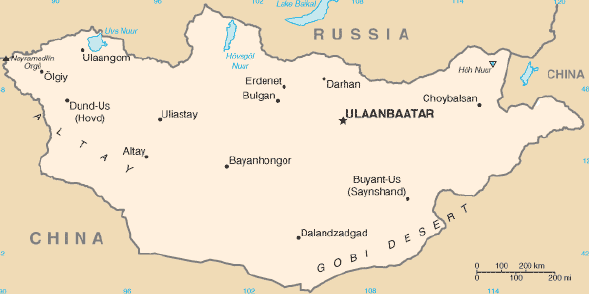| Mongolia Table of Contents
The terrain is one of mountains and rolling plateaus, with a high degree of relief. Overall, the land slopes from the high Altai Mountains of the west and the north to plains and depressions in the east and the south. Hutyen Orgil (sometimes called Nayramadlin Orgil--Mount Friendship) in extreme western Mongolia, where the Mongolian, the Soviet, and the Chinese borders meet, is the highest point (4,374 meters). The lowest is 560 meters, an otherwise undistinguished spot in the eastern Mongolian plain. The country has an average elevation of 1,580 meters. The landscape includes one of Asia's largest freshwater lakes (Hovsgol Nuur), many salt lakes, marshes, sand dunes, rolling grasslands, alpine forests, and permanent montane glaciers. Northern and western Mongolia are seismically active zones, with frequent earthquakes and many hot springs and extinct volcanoes.
Mongolia has three major mountain ranges. The highest is the Altai Mountains, which stretch across the western and the southwestern regions of the country on a northwest-to-southeast axis. The Hangayn Nuruu, mountains also trending northwest to southeast, occupy much of central and north-central Mongolia. These are older, lower, and more eroded mountains, with many forests and alpine pastures. The Hentiyn Nuruu, mountains near the Soviet border to the northeast of Ulaanbaatar, are lower still. Much of eastern Mongolia is occupied by a plain, and the lowest area is a southwest-to-northeast trending depression that reaches from the Gobi region in the south to the eastern frontier. The rivers drain in three directions: north to the Arctic Ocean, east to the Pacific, or south to the deserts and the depressions of Inner Asia. Rivers are most extensively developed in the north, and the country's major river system is that of the Selenge-Moron, which drains into Lake Baykal. Some minor tributaries of Siberia's Yenisey River also rise in the mountains of northwestern Mongolia. Rivers in northeastern Mongolia drain into the Pacific through the Argun and Amur (Heilong Jiang) rivers, while the few streams of southern and southwestern Mongolia do not reach the sea but run into salt lakes or deserts.
Climate 
Custom Search
Source: U.S. Library of Congress |
